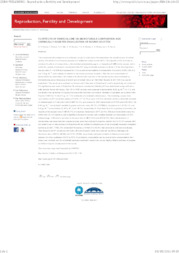Effects of demecolcine on microtubule composition and chemically assisted enucleation of bovine oocytes.
Effects of demecolcine on microtubule composition and chemically assisted enucleation of bovine oocytes.
Autoria: SARAIVA, N. Z.; PERECIN, F.; MÉO, S. C.; FERREIRA, C. R.; TETZNER, T. A. D.; OLIVEIRA, J. C.; GARCIA, J. M.
Resumo: The developmental competence of enucleated oocytes is a key factor that determines the overall success of animal cloning. Enucleation is an invasive procedure in traditional nuclear transfer (NT). The objective of this work was to evaluate the effects of demecolcine, a microtubule-depolymerizing agent, on metaphase II (MII) bovine oocytes and to verify the capacity of embryonic development after NT using chemically assisted enucleation. In the first experiment, oocytes after 21 h of IVM were exposed for 2 h to several concentrations of demecolcine: 0 (control), 0.025, 0.05, 0.2, and 0.4 µg mL?1, and evaluated in relation to membrane protrusion formation. After the best concentration of demecolcine was determined, the nuclear and microtubular dynamics of the treated oocytes were evaluated by immunofluorescence microscopy of tubulin and chromatin (Liu et al. 1998 Biol. Reprod. 5, 537?545) in a second experiment. The results were analyzed by Duncan and Tukey tests in Experiments I and II, respectively, and a level of 5% significance was used. In Experiment III, embryonic development following NT was determined using adult donor cells, derived from a skin biopsy. After 19 h of IVM, oocytes were exposed to demecolcine (0.05 µg mL?1) for 2 h, and enucleation was performed in oocytes that presented membrane protrusions. Samples of cytoplasts were stained with Hoechst 33342 for 10 min (10 µg mL?1) for evaluation of enucleation effectiveness. The remaining oocytes were reconstituted by NT, fused (two pulses of 2.0 kV cm?1 for 20 µs each, in 0.28 m mannitol solution), chemically activated (5 mm ionomycin for 5 min and 2 mm 6-DMAP for 4 h), and cultured in SOF medium with 2.5% FCS and 0.5% BSA. The 0.05 µg mL?1 concentration resulted in greater protrusion rates (55.1%; 211/388) in comparison to 0, 0.025, 0.2, and 0.4 µg mL?1 concentrations (0, 42.6, 45.1, and 39.3%, respectively). In Experiment II, at the beginning of treatment, the majority of the oocytes were in MII (40.7%) or anaphase I/telophase I (AI/TI; 22.4%). Effects of demecolcine occurred within only 0.5 h of treatment, with a significant increase in oocytes with complete depletion of microtubules (21.8%; initial average: 1.9%) and a reduction in the proportion at MII (13.5%) and AI/TI (8.2%). New polymerization of microtubules was observed when treated oocytes were then cultured in drug-free medium for 6 h (42.4% oocytes with two evident sets of microtubules). In Experiment III, we verified the effectiveness of the chemically assisted enucleation technique (90.6%; 77/85). We evaluated 515 oocytes, of which 219 (42.5%) had protrusions and were enucleated. After losses in the NT procedure and fusion, 58 reconstructed 1-cells were cultured resulting in cleavage and blastocyst rates of 84.5% (49/58) and 27.6% (16/58), respectively, with great variation in blastocyst production between the three replicates (12.5% to 47%). In conclusion, demecolcine can be used at lower concentrations than those used routinely, and the chemically assisted enucleation method has proven highly efficient and does not appear to inhibit embryonic development in the bovine
Ano de publicação: 2008
Tipo de publicação: Resumo em anais e proceedings
Unidade: Embrapa Pecuária Sudeste
Observações
1 - Por padrão são exibidas publicações dos últimos 20 anos. Para encontrar publicações mais antigas, configure o filtro ano de publicação, colocando o ano a partir do qual você deseja encontrar publicações. O filtro está na coluna da esquerda na busca acima.
2 - Para ler algumas publicações da Embrapa (apenas as que estão em formato ePub), é necessário ter, no celular ou computador, um desses softwares gratuitos. Sistemas Android: Google Play Livros; IOS: iBooks; Windows e Linux: software Calibre.
Acesse outras publicações
Acesse a Base de Dados da Pesquisa Agropecuária (BDPA) para consultar o acervo completo das bibliotecas da Embrapa.

